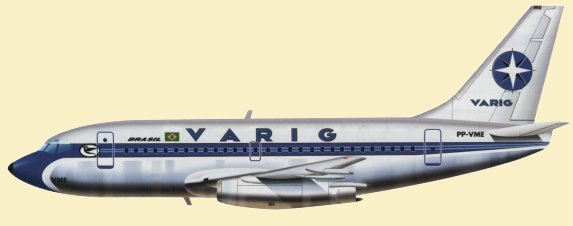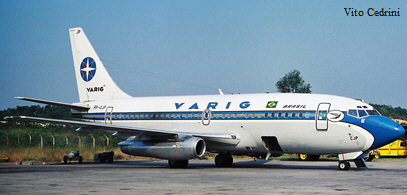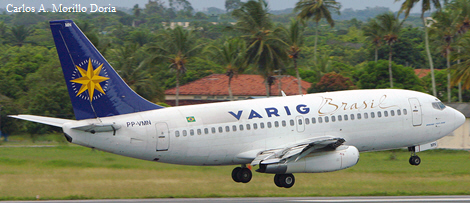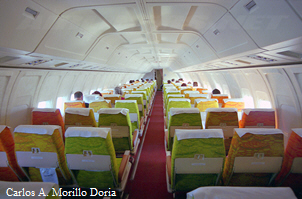|
AIRCRAFT |
||||||
|
|
Continuing with its fleet renovation and enhancement program, during 1974 four Boeing 737-200 Super Advanced aircraft started operating, besides DC-10 aircraft. Those B737 were introduced in domestic lines and with them VARIG was able to increase the frequency of its major flights in Brazil, thus increasing the offer of seats to its users. The first B737 Super Advanced, PP-VME, came from the factory in Seattle, United States and arrived in Brazil on November 1974.
The original order consisted of ten units, coming directly from Boeing plant. More three units (PP-VMF, PP-VMG and PP-VMH) were received in 1974. The remaining six units (PP-VMI, PP-VMJ, PP-VMK, PP-VML, PP-VMM and PP-VMN ) were received throughout 1975. The initial ten Boeing 737-200s started to operate on domestic routes, replacing Electra II, which started to operate exclusively on Rio-São Paulo "Air Bridge" service. The first routes were between Rio de Janeiro, São Paulo, Vitória, Belo Horizonte, Curitiba, Florianópolis, Brasília, Salvador, Belém, Santarém and Manaus. Later, Boeing 737-200 also started to operate the lines served by Avro HS748. B737's first international route was to Asunción.
In 1975, after purchase Cruzeiro,
VARIG B737 grew with six more units, totaling sixteen Boeing
737-200. At the time, Brazilian airlines emphasized the words “Super
Advanced” to give a feeling that the aircraft was more modern and
advanced than the others. Actually it was a Boeing 737-200 Advanced
that had improvements over the initial version and more powerful engines.
In May 1982, VARIG received more two units, PP-VNF and PP-VNG,
previously operated by Bavaria airline, totaling 18 Boeing 737-200s
operated simultaneously (twelve at VARIG and six at Cruzeiro).
In September 1987 VARIG received the first Boeing 737-300, B737 new
generation. At that time Rede Globo was showing the soap opera
called Brega & Chique (tacky and chic). Thus Boeing 737-200 were
nicknamed Brega and Boeing 737-300 Chique. With Boeing 737 new
generation, Boeing 737-200 began to be replaced.
In November 1996 and February 1997, VARIG acquired the last two Boeing 737-200 units, PP-VPD and PP-VPE, respectively. These aircraft operated most time for Pluna, a Uruguayan company that was part of VARIG Group. In 1998 PP-VMI and PP-VPD were transferred to Pluna. In December 1999 PP-VNG was returned and, in June, PP-VPE was transferred to Pluna. In 2001 the PP-VME and PP-VMN were leased to Nacional and returned to VARIG in 2002.
By the beginning of 2002, all
Boeing 737-200s were already out of operation, but due to it
financial crisis, VARIG reactivated four Boeing 737-200 (PP-VME,
PP-VMF, PP-VMH and PP-VMN). These aircraft operated from August 2002
to June 2003. The unexpected return meant that some of them did not
receive the complete painting and operated with white engines and
belly instead of traditional dark blue.
In December 2002 PP-VNF was returned. PP-VMJ, PP-VMM, PP-VMN, PP-VMG
and PP-VML were returned throughout 2003. In 2004 PP-VME was
returned. PP-VMH was stocked in 2003.
The PP-VMK became famous after suffering an accident in September
1989. After getting lost on a flight between Carajás and Belém, the
aircraft made an emergency landing in the middle of the Amazon
rainforest, in the municipality of São José do Xingú.
VARIG's Boeing 737-200 internal configuration:
1st: 110 seats
Business Class: 12 seats (2+2 seats per row)
Economy Class: 98 seats (3+3 seats per row)

2nd: 109 seats (Economy Class only)

|











